Reconstitution of the oocyte nucleolus in mice through a single nucleolar protein, NPM2
- PMID: 28600324
- PMCID: PMC6139372
- DOI: 10.1242/jcs.195875
Reconstitution of the oocyte nucleolus in mice through a single nucleolar protein, NPM2
Abstract
The mammalian oocyte nucleolus, the most prominent subcellular organelle in the oocyte, is vital in early development, yet its key functions and constituents remain unclear. We show here that the parthenotes/zygotes derived from enucleolated oocytes exhibited abnormal heterochromatin formation around parental pericentromeric DNAs, which led to a significant mitotic delay and frequent chromosome mis-segregation upon the first mitotic division. A proteomic analysis identified nucleoplasmin 2 (NPM2) as a dominant component of the oocyte nucleolus. Consistently, Npm2-deficient oocytes, which lack a normal nucleolar structure, showed chromosome segregation defects similar to those in enucleolated oocytes, suggesting that nucleolar loss, rather than micromanipulation-related damage to the genome, leads to a disorganization of higher-order chromatin structure in pronuclei and frequent chromosome mis-segregation during the first mitosis. Strikingly, expression of NPM2 alone sufficed to reconstitute the nucleolar structure in enucleolated embryos, and rescued their first mitotic division and full-term development. The nucleolus rescue through NPM2 required the pentamer formation and both the N- and C-terminal domains. Our findings demonstrate that the NPM2-based oocyte nucleolus is an essential platform for parental chromatin organization in early embryonic development.
Keywords: Heterochromatin; Nucleolus; Nucleoplasmin 2; Oocyte.
© 2017. Published by The Company of Biologists Ltd.
Conflict of interest statement
Competing interestsThe authors declare no competing or financial interests.
Figures
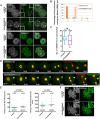
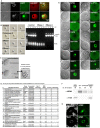
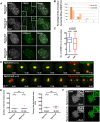

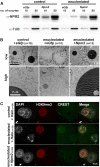
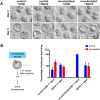
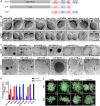
Similar articles
-
Roles of NPM2 in chromatin and nucleolar organization in oocytes and embryos.Science. 2003 Apr 25;300(5619):633-6. doi: 10.1126/science.1081813. Science. 2003. PMID: 12714744
-
Role of the nucleoplasmin 2 C-terminal domain in the formation of nucleolus-like bodies in mouse oocytes.FASEB J. 2010 Feb;24(2):485-94. doi: 10.1096/fj.09-143370. Epub 2009 Oct 5. FASEB J. 2010. PMID: 19805576
-
Involvement of mouse nucleoplasmin 2 in the decondensation of sperm chromatin after fertilization.Biol Reprod. 2011 Jul;85(1):70-7. doi: 10.1095/biolreprod.110.089342. Epub 2011 Mar 17. Biol Reprod. 2011. PMID: 21415138
-
Ribosomal RNA and nucleolar proteins from the oocyte are to some degree used for embryonic nucleolar formation in cattle and pig.Theriogenology. 2007 Sep 1;68 Suppl 1:S63-70. doi: 10.1016/j.theriogenology.2007.03.015. Epub 2007 Apr 26. Theriogenology. 2007. PMID: 17466364 Review.
-
Nucleolus precursor body (NPB): a distinct structure in mammalian oocytes and zygotes.Nucleus. 2014;5(6):493-8. doi: 10.4161/19491034.2014.990858. Nucleus. 2014. PMID: 25495074 Free PMC article. Review.
Cited by
-
Nucleolus as an emerging hub in maintenance of genome stability and cancer pathogenesis.Oncogene. 2018 May;37(18):2351-2366. doi: 10.1038/s41388-017-0121-z. Epub 2018 Feb 12. Oncogene. 2018. PMID: 29429989 Free PMC article. Review.
-
Nucleoli in embryos: a central structural platform for embryonic chromatin remodeling?Chromosome Res. 2019 Mar;27(1-2):129-140. doi: 10.1007/s10577-018-9590-3. Epub 2018 Nov 8. Chromosome Res. 2019. PMID: 30406864 Review.
-
Immunocytochemical detection of proteins within cellular structures inaccessible to specific antibodies.Histochem Cell Biol. 2025 May 17;163(1):53. doi: 10.1007/s00418-025-02387-0. Histochem Cell Biol. 2025. PMID: 40381002 Review.
-
Nucleolus and rRNA Gene Chromatin in Early Embryo Development.Trends Genet. 2019 Nov;35(11):868-879. doi: 10.1016/j.tig.2019.06.005. Epub 2019 Jul 18. Trends Genet. 2019. PMID: 31327501 Free PMC article. Review.
-
Maternal factors regulating preimplantation development in mice.Curr Top Dev Biol. 2020;140:317-340. doi: 10.1016/bs.ctdb.2019.10.006. Epub 2019 Nov 19. Curr Top Dev Biol. 2020. PMID: 32591079 Free PMC article. Review.
References
-
- Arney K. L., Bao S., Bannister A. J., Kouzarides T. and Surani M. A. (2002). Histone methylation defines epigenetic asymmetry in the mouse zygote. Int. J. Dev. Biol. 46, 317-320. - PubMed
MeSH terms
Substances
Grants and funding
LinkOut - more resources
Full Text Sources
Other Literature Sources
Molecular Biology Databases

